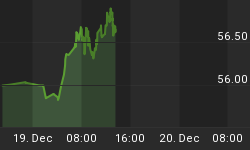You can hear the teeth chattering all the way to Atlanta. It's the sound of traders on Wall Street getting jittery about inflation, or more specifically, what the FOMC will do about it. Their fears have been spurred by anti-inflationary rhetoric uttered by Fed governors and reinforced by recent earnings reports in which poor results have been blamed on higher costs. The last thing bulls need is lower earnings being caused by a bout with inflation rather than having the demand associated increased earnings causing the inflation. But thanks to those useless institutions known as central banks, this undesirable scenario is exactly what the world faces.
Given the rhetoric, the FOMC has already committed itself to at least another quarter point hike on June 29, and based on recent market action, the consensus expectation appears to call for another 25bp hike along with little change in the post-parlor proclamation. There are two ways, then, in which the Fed could surprise us. First, we could see a half point hike. If the governors are truly as worried about inflation as they say, such a move would be reasonable. However, seeing a 50bp hike carries very low odds given the predicament of debt in which this nation bastes. Second, they could hike and say they are done or simply not hike at all. If the Fed wishes to maintain any sort of credibility whatsoever, this second scenario simply is not feasible. Therefore, the consensus may have achieved the rare feat of being correct.
Where reality may deviate from expectations is in what happens at the August meeting. Interest rate futures currently place high probability on yet another 25bp hike. If the markets can manage to hold things together between now and then, we may see that hike, but it seems more probable that the extent of economic damage being posed by the fall of housing will expose itself by then, forcing the Fed to pause or even begin cutting. It's quite ironic that once the "one and done" theme was negated from the collective mindset, it may have become perfectly valid.
The environment we are currently witnessing represents a transitional phase for the markets. For the last three years, we have been in a liquidity-driven market, as witnessed by the fact that real and financial assets have both held a positive correlation to one another. Once the aftermath of the housing bubble begins to become evident on an operational level, meaning forcing tighter conditions of economic scarcity on individual decision-making, we will face a crisis marking the end of the transitional phase and the beginning of a value-driven market. In value-driven markets, real and financial assets maintain their long-term relationship of being inversely correlated. Since the transition we are witnessing involves a shift of focus from financial to real assets, we will see stocks and bonds continue to languish on the heels of the crisis while commodity prices resume their bull market.
The last time such a major transition took place was the early 1980s when the respectable Mr. Volcker took interest rates into double digits in order to contain the destructive forces of inflation. Between 1980-82, we saw markets endure a transitional phase in which real and financial assets both moved downward in price. As with current markets, the positive correlation was liquidity-driven, and the period heralded a transition of leadership. Furthermore, the end of the transitional phase coincided with the end of an interest rate tightening cycle.
The transition that concluded in 1982 preceded the greatest bull market financial assets have ever seen. The foundations for such a period were set by Mr. Volcker's disciplined monetary policies which cleared inefficiencies from our economy and allowed resources to be reallocated more astutely and hence with higher returns. Likewise, the current transition is likely to precede the greatest bull market real assets have ever seen. The foundations for this commodity bull market have also been set by monetary policy, only in this cycle the approach has been very undisciplined. Excessive liquidity has promoted and sustained inefficient capital allocation, thereby straining already scarce resources. Combined with a burgeoning world population and the emerged economies of India and China, this period of resource scarcity promises to bring geopolitical tensions, as well... an environment that can only intensify competition for commodities.
What the FOMC does in the next couple of meetings will amount to nothing more than showmanship. The stage is set for market turmoil that will force them into an easier posture... a move that will presage a great boom in the prices of raw materials.















